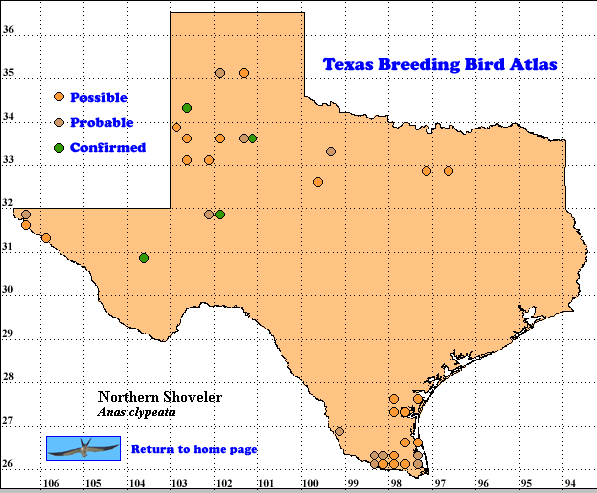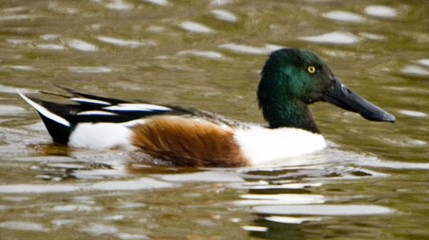Northern Shoveler is one of at least 4 species of shovelers within the genus Anas, whose distribution covers 5 continents (Monroe and Sibley 1993). With their spoonbill-like mandibles, these dabbling ducks can filter small aquatic creatures and seeds from the water, giving them a richer diet than those of other dabblers. This enables shovelers to seemingly crowd small ponds. With their distinctive bill shape and plumage, males are easily recognized. They are almost as well known in North America as Mallards (A. platyrhynchos; Dubowy 1996).
DISTRIBUTION. During the 1987-1992 field work seasons of the TBBA project, atlasers found breeding evidence for Northern Shovelers mainly in the High Plains, South Texas Brush Country, Coastal Sand Plain and Trans-Pecos regions (see the region map in Lockwood and Freeman [2004]). The atlasers found 3 confirmed sites in the Panhandle as well as 1 in the central Trans-Pecos region. Of the 13 probable sites, 8 were in the southern tip of the state (latilongs 26097, 26098 and 26099), 2 were in the Panhandle and one was in the western Trans-Pecos. Many of the 29 possible sites were in these regions, while others were widely scattered.
In Oklahoma atlasers found about a dozen probable breeding sites scattered through the western and central portions of the state (Young 2004). In nearby Colorado atlasers found half of the state’s breeding sites on the eastern plains where the habitat is similar to the High Plains of Texas (Boyle 1998).
Elsewhere Northern Shovelers breed in greatest numbers in the Canadian prairie provinces, North Dakota and the Klamath Basin area of Oregon and California. These ducks also breed from Alaska south to Utah and central New Mexico as well as near the Great Lakes and along the St. Lawrence River. This species winters at lower elevations through the western, south-central and southeastern United States as well as most of the Atlantic coast. The winter range also includes most of Mexico, the Greater Antilles and the Pacific coast of Central America. Other populations are widespread in the Old World (Howell and Webb 1995, Dubowy 1996, Am. Ornithol. Union 1998).
SEASONAL OCCURRENCE. Northern Shovelers breed from about April to July, based on observations of downy young from May14 to June 30. Nesting records before 1970 are rare and mostly near the coast. These ducks are common to abundant migrants and winter residents. Their wintering season extends from early September to mid-May (Oberholser 1974, Lockwood and Freeman 2004).
BREEDING HABITAT. Northern Shovelers breed in Texas from near sea level to about 1150 m (3800 ft) generally in shallow, often stagnant, fresh water sloughs, creeks and ponds fringed with dense vegetation (Oberholser 1974). These ducks prefer to nest in short grass near a body of water, but may also use hayfields, meadows or emergent vegetation now out of water. The female selects the site and scrapes a shallow bowl, 20 cm (8 in) in diameter and 2 cm (0.8 in) deep which she lines with dry grasses and forbs and down feathers (see photo in Harrison [1979]; Dubowy 1996).
In the bowl the female lays an average of 10-11 smooth, pale olive-buff to pale greenish-gray eggs at the rate of one per day. These are almost indistinguishable from those of Mallards or Northern Pintails (A. acuta.) The female incubates the eggs for an estimated 23-25 days, starting during egg laying. After hatching, the ducklings are led to water by the female who stays with them while they feed on zooplankton and small invertebrates until they are capable of flight about 7 weeks after hatching. One brood is reared per season (Harrison 1979, Dubowy 1996).
STATUS. Lockwood and Freeman (2004) consider Northern Shovelers uncommon in summer in the Panhandle and rare and local in the rest of Texas. This duck is at the edge of its breeding range in the Panhandle and breeding will probably always be variable depending on climatic conditions. Although shovelers ares harvested by hunters, BBS data provide a significant trend of +3.7% for 1980-2006 in North America (Sauer et al. 2007).
Text by Robert C. Tweit (2008)

Literature cited.
American Ornithologists’ Union. 1998. Checklist of North American birds, 7thed. Am, Ornithol. Union, Washington, DC.Boyle, S. 1998. Northern Shoveler (Anas clypeata). In Colorado breeding bird atlas, pp. 82-83 (H. E. Kingery, ed.), Colorado Bird Atlas Partnership, Denver.
Dubowy, P. J. 1996. Northern Shoveler (Anas clypeata). InThe birds of North America, No. 217 (A. Poole and F. Gill, eds.). The Birds of North America, Inc., Philadelphia, PA.Harrison, H. H. 1979. A field guide to western birds’ nests. Houghton Mifflin, Boston, MA.
Howell, S. N. G. and S. Webb. 1995. A guide to the birds of Mexico and northern Central America. Oxford University Press, New York.
Lockwood, M. W. and B. Freeman. 2004. The TOS handbook of Texas birds. Texas A&M University Press, College Station.
Monroe, B. L., Jr. and C. G. Sibley. 1993. A world checklist of birds. Yale University Press, New Haven, CT.Oberholser, H. C. 1974. The bird life of Texas. University of Texas Press, Austin.
Sauer, J. R., J. E. Hines, and J. Fallon. 2007. The North American breeding bird survey, results and analysis 1966-2006. Version 7.23.2007. USGS Patuxent Wildlife Research Center, Laurel MD < http://www.mbr-pwrc.usgs.gov/bbs>
Young, E. A. 2004. Northern Shoveler (Anas clypeata). In Oklahoma breeding bird atlas, pp. 74-75 (D. L. Reinking, ed.). University of Oklahoma Press, Norman.
